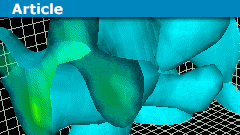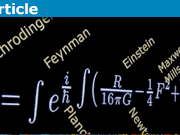Learn the Physics of Virtual Particles in Quantum Mechanics
In discussions on the internet (including a number of Wikipedia pages) and in books and articles for non-experts in particle physics, there is considerable confusion about various notions around the concept of particles of subatomic size, and in particular about the notion of a virtual particle. This is partly due to misunderstandings in the terminology used, and partly due to the fact that subatomic particles manifest themselves only indirectly, thus leaving a lot of leeway for the imagination to equip these invisible particles with properties, some of which sound very magical. How the latter view could arise is described in the Insight Article, ”The Vacuum Fluctuation Myth”.
The aim of the following exposition is a definition of physical terms essential for an informed discussion of which of these properties have a solid basis in physics, and which of these are gross misconceptions or exaggerations that shouldn’t be taken seriously. Such a discussion is begun in another Insight Article “Misconceptions about Virtual Particles“. A further Insight Article, ”Vacuum Fluctuations in Experimental Practice”, shows the example of a recent article in the scientific literature how some authors claim the observation of vacuum fluctuations, justified only by superficial, invalid reasoning.
In the following, I give precise definitions of many terms, telling what they really mean as part of the technical language used in quantum field theory. They have meaning only in this precisely defined context and are meaningless otherwise. For example, virtual particles have a technical meaning in a discussion of Feynman diagrams, but not in stories where they are claimed to pop in and out of existence. Similarly, vacuum fluctuations have a technical meaning in a discussion of certain vacuum expectation values, but not in stories where they are claimed to describe a sizzling vacuum or to cause a physical effect.
Table of Contents
Physical system
A physical system is characterized abstractly by the collection of observables that are meaningfully assignable to the system, the defining commutation relations specifying a Lie algebra, and its representation on a Hilbert space. The spectral analysis of this representation determines the possible values the observables can take. The most well-known example is an oscillator, whose observables are scalar position and momentum variables satisfying the canonical commutation rules and can take arbitrary real values.
Particle
Particles are particularly simple physical systems. Particles of subatomic size are described in physics by relativistic quantum field theory. Contrary to the naive view as tiny bullets, particles are described on this fundamental level as oscillations of the quantum fields, typically partially localized in a beam. The mass ##m## of a massive particle is proportional to the (angular) oscillation frequency ##\omega## in their rest frame, according to the formula ##\hbar\omega=E=mc^2##, where ##\hbar## is Planck’s constant, ##c## the speed of light, and ##E## the rest energy of the particle. Thus real mass is the relativistic analog of real frequencies, corresponding to stable particles and stable oscillations, and complex mass is the relativistic analog of complex frequencies, corresponding to decaying particles and decaying oscillations.
Elementary particle
Whether a particle is or is not elementary depends on the description level. As our knowledge about microscopic physics increases, objects once considered elementary were found to have a substructure that can be modeled on a more detailed level. Thus atoms, once thought of as elementary are today described as consisting of nuclei and electrons; nuclei are described as consisting of protons and neutrons, and the latter is thought of consisting of quarks. Whether quarks have substructure is presently unknown.
A particle is considered to be elementary (on a given description level) if it is sufficient to describe it by an irreducible unitary representation of the Poincare group or its Lie algebra. This group is dictated in QFT by the symmetries of space-time at experimental microscopic scales. The 10 independent observables of this Lie algebra are the four components of a 4-vector ##p## describing momentum, three components of a 3-vector ##J## describing angular momentum, and three components of another 3-vector ##K## describing infinitesimal boosts.
For massive particles such as the electron, one can construct from these an additional 3-vector ##q## describing the particle position in an observer-dependent frame. For massless particles such as the photon, a sensible position vector does not exist.
States
A specific instance of the physical system is described by a state – either a pure state specified by a normalized state vector ##\psi## in the Hilbert space of the system, or a mixed state specified by a Hermitian positive semidefinite density operator ##\rho## of trace 1 acting on the Hilbert space; this also covers the pure case with ##\rho=\psi\psi^*##. (This is the linear operator with ##\rho\phi:=\psi(\psi^*\phi)##, where the term in parentheses is the inner product. Thus ##\langle A\rangle=Tr~\rho A=\psi^*A\psi## for pure states.) The state specifies the probabilities with which the observables can be observed in appropriate experiments. Unless the state of a physical system is specified it is impossible to say anything at all about its observables, apart from the possible values they can take when realized through a state. Thus states are necessary to relate the formal properties to reality. Properties not expressible in terms of states have no observable meaning.
Observable particles
Relativistic quantum field theory (QFT) is the theory for predicting the results of collision experiments, the main source of information about subatomic particles. In relativistic QFT, observable – hence undisputably real – particles of mass ##m## are asymptotic objects, sufficiently far (in theory infinitely far) away that their interactions can be neglected. This is the content of the cluster decomposition principle, realized through the S-matrix, in which a time limit ##t\to\pm\infty## is performed. Negative infinite time corresponds to (typically two) ingoing particles in a collision experiment, positive infinite times to (typically two or more) outgoing particles, the collision products.
Observable particles are conventionally defined as being associated with poles of the S-matrix at energy ##E=mc^2## in the rest frame of the system (Peskin/Schroeder, An introduction to QFT, p.236). If the pole is at a real energy, the mass is real and the particle is a stable bound state; if the pole is at a complex energy (in the analytic continuation of the S-matrix to the second sheet), the mass is complex and the particle is unstable. At energies larger than the real part of the mass, the imaginary part determines its decay rate and hence its lifetime (Peskin/Schroeder, p.237); at smaller energies, the unstable particle cannot form for lack of energy, but the existence of the pole is revealed by a Breit-Wigner resonance in certain cross-sections. From its position and width, one can estimate the mass and the lifetime of such a particle before it has ever been observed. Indeed, many particles listed in the tables by the Particle Data Group (PDG) are only known as resonances.
Stable and unstable particles
A stable particle can be created and annihilated, as there are associated creation and annihilation operators that add or remove particles to the state. According to the QFT formalism, these particles must be on-shell. This means that their momentum ##p## is related to the real rest mass ##m## by the relation ##p^2=m^2## (in units where ##c=1## and in a metric with signature ##+ – – -##). More precisely, it means that the 4-dimensional Fourier transform of the time-dependent single-particle wave function associated with it has support that satisfies the relation ##p^2=m^2##. There is no need for this wave function to be a plane wave, though these are taken as the natural unnormalized basis functions between the scattering matrix elements are taken.
An unstable particle is represented quantitatively by a so-called Gamov state, also called a Siegert state, in a complex deformation of the Hilbert space of a QFT obtained (e.g., thorough complex scaling) by analytic continuation of the formulas for stable particles. In this case, as ##m## is complex, the mass shell consists of all complex momentum vectors ##p## with ##p^2=m^2## and ##v=p/m## real, and states are composed exclusively of such momentum vectors. This is the representation in which one can take the limit of zero decay, in which the particle becomes stable (such as the neutron in the limit of negligible electromagnetic interaction), and hence the representation appropriate in the regime where the unstable particle can be observed (i.e., resolved in time). Note that particles that are unstable in the standard model of QFT may be stable in a submodel – for example, the neutron is an unstable particle, decaying through the weak force, but within QCD (which models only the strong force) it is a stable bound state of three quarks.
Resonances
A second representation of unstable particles in terms of normalizable states of real mass is given as the superposition of the scattering states of their decay products, involving all energies in the range of the Breit-Wigner resonance. In this standard Hilbert space representation, the unstable particle is never formed; so this is the representation appropriate in the regime where the unstable particle reveals itself only as a resonance. For example, the 2010 PDG description of the Z boson discusses both descriptions of the unstable ##Z## in quantitative detail (p.2: Breit-Wigner approach; p.4: S-matrix approach). For the ##\rho## meson, see, e.g., the slides by Hendrik van Hees.
Branching fractions
If an unstable particle can decay in several different ways, the branching fraction of every single decay (or group of decays) is the relative frequency of this decay (or group of decays) compared to all decays. It can be computed from the S-matrix elements of all individual processes.
Transition states
These are short-living (hence real) intermediate states in a chemical (or nuclear) reaction, or any other collision process, often visible as resonances. Their theory is a well-developed science in the case of chemical and nuclear reactions, and it applies in principle down to the smallest scales. See, e,g,, Hänggi, P., Talkner, P., & Borkovec, M. (1990). Reaction-rate theory: fifty years after Kramers. Reviews of modern physics, 62(2), 251.
Quasiparticles
The particles described by the S-matrix are the elementary excitations of the vacuum state. At finite temperature and in general relativity, the asymptotic particle concept in quantum field theory must be modified to take account of a nontrivial background. Typically, the background (which takes the place of the vacuum state) is modeled as a coherent state or a squeezed state, or their fermionic analog. Quasiparticles are the elementary excitations of the background, treated as if it were a vacuum state; the background also deforms the mass shell, leading to a dispersion law different from ##p^2=m^2##. Moreover, the space-time symmetry is broken. Typical examples of quasiparticles are phonons in solid-state physics and Cooper pairs in superconductivity. Quasiparticles are associated with states and creation and annihilation operators, hence are as real as ordinary particles.
On-shell and off-shell particles
The mass shell of a particle of (real or complex) mass ##m## is the 3-dimensional quadric ##p^2=m^2## in 4-dimensional momentum space. On-shell means that this equation holds, off-shell that this equation is violated. All observable particles are on-shell, though the mass shell is real only for stable particles. Therefore, off-shell particles (also called virtual particles; see below) are necessarily unobservable.
Feynman diagrams
Feynman diagrams describe how the terms in a series expansion of the S-matrix elements arise in a perturbative treatment of the interactions as linear combinations of multiple integrals. Each such multiple integrals is a product of vertex contributions and propagators, and each propagator depends on a 4-momentum vector that is integrated over. In addition, there is a dependence on the momenta of the ingoing (prepared) and outgoing (in principle detectable) particles.
The structure of each such integral can be concisely represented by a Feynman diagram. This is done by associating with each vertex a node of the diagram and with each momentum a line; for ingoing momenta an external line ending in a node, for outgoing momenta an external line starting in a node, and for propagator momenta an internal line between two nodes. The detailed correspondence is given by the so-called Feynman rules found in every QFT book.
The resulting diagrams can be given a very vivid but superficial interpretation as the worldlines of particles that undergo a metamorphosis (creation, deflection, or decay) at the vertices. In this interpretation, the in- and outgoing lines are the worldlines of the prepared and detected particles, respectively, and the others are dubbed virtual particles, not being real but required by this interpretation. This interpretation is related to – and indeed historically originated with – Feynman’s 1945 intuition that all particles take all possible paths with a probability amplitude given by the path integral density. Unfortunately, such a view is related to the formal, unrenormalized path integral only. But on the unrenormalized level, all contributions of diagrams containing loops are infinite, defying a probability interpretation.
External lines and off-shell particles
As a consequence of the description of S-matrix elements, the external lines usually correspond to on-shell particles. and then describe real particles before and after a collision or decay. However, there is the custom of using (generalized) Feynman diagrams also in certain cases where one or more out-particles are off-shell (typically denoted by a *). An example (see Figure 2 in http://arxiv.org/abs/hep-ph/9807536) is the Higgs decay ##H\to WW^*## in which one of the ##W## produced is off-shell, hence not a real particle but an unobservable label. Such a Feynman diagram is short-hand for a family of Feynman diagrams obtained by attaching to each off-shell particle another vertex and its admissible interaction partners, in case of the ##W^*## two leptons. Thus the single Feynman diagram visualizing the decay ##H\to WW^*## stands in fact for ##H\to WX##, where ##X## are two external lepton lines attached to a vertex that turns ##W^*## into an internal line, as it should be for off-shell particles. The branching fractions for decays involving off-shell particles must be interpreted in the same way. For example, the branching factor for the decay ##H\to WW^*## is defined as the inclusive branching factor for all ##H\to WX##, where ##X## are two observable leptons consistent with the standard model interactions.
Virtual particles
Virtual particles are defined as (intuitive imagery for) internal lines in a Feynman diagram (Peskin/Schroeder, p.5, or Zeidler, QFT I Basics in mathematics and physics, p.844). They are frequently used by professionals to illustrate processes in quantum field theory, and as a very useful shorthand language for complicated multivariate integrals over internal (real, but off-shell) momenta. According to the definition in terms of Feynman diagrams, a virtual particle has a real mass and specific values of 4-momentum, spin, and charges characterizing the form and variables in its defining propagator. As the 4-momentum is integrated over all of ##R^4##, there is no mass shell constraint, hence virtual particles are off-shell. The word virtual is an antonym to real – unlike the general readership of popular literature on particle physics, the creators of the terminology were well aware that virtual particles are not real in any observable sense. See the final paragraph of this article.
Informally, virtual particles are primarily viewed as transmitting the fundamental forces in quantum field theory. The electromagnetic force is transmitted by virtual photons. The weak force is transmitted by virtual Zs and Ws. The strong force is transmitted by virtual gluons. The physics underlying this figurative speech is in the Feynman diagrams, primarily in the simplest tree diagrams that encode the low order perturbative contributions of interactions to the classical limit of scattering experiments. (Thus the tree diagrams are really a manifestation of classical perturbative field theory, not of quantum fields. Quantum corrections involve at least one loop.)
Virtual states
In nonrelativistic scattering theory, one also meets the concept of virtual states, denoting states of real particles on the second sheet of the analytic continuation, having well-defined but purely imaginary energy, defined as a pole of the S-matrix. See, e.g., Thirring, A course in Mathematical Physics, Vol 3, (3.6.11).
The term virtual state is used with a different meaning in virtual state spectroscopy and denotes there an unstable energy level above the dissociation threshold, with small imaginary parts. This is equivalent to the concept of a resonance discussed above.
Virtual states have nothing to do with virtual particles, which have real energies but no associated states, though sometimes the name ”virtual state” is associated with the latter.
Misconceptions about virtual particles
That Feynman diagrams display virtual particles ”transmitting” the fundamental forces proves the ”existence” of virtual particles in the eyes of their aficionados. But since they lack states (multiparticle states are always composed of on-shell particles only), they lack reality in any meaningful sense. States involving virtual particles cannot be created for lack of corresponding creation operators in the theory. Thus they cannot cause anything or interact with anything. In short, virtual particles are ”virtual” particles only, as their name says.
For a fuller discussion of the many widespread misconceptions surrounding the concept of virtual particles see Chapter A8: ”Virtual particles and vacuum fluctuations” of my theoretical physics FAQ. Se also the discussions on this forum here, here, here, and here. Finally, see also this thread from Physics Stack Exchange, a predecessor of the above text, and the discussions here and there relating to that thread.
I’ll close with a clarification of the scientific content of some often misunderstood concepts related to the vacuum.
Vacuum fluctuations
This is the term associated with the formal fact that the distribution of a smeared electromagnetic field operator in the vacuum state of a free quantum field theory is a Gaussian. (See p. 119 in the book Quantum Field Theory by Itzykson and Zuber 1980.)
According to the Born rule, the distribution of a quantum observable gives the probabilities for measuring values for the observable in independent, identical preparations of the system in identical states. Thus the presence of a Gaussian distribution means that the value of the electromagnetic field in the vacuum state is not determined with arbitrary precision but has inherent uncertainty.
No temporal or spatial implications can be deduced. (The distribution itself is independent of time and space.) Thus it is misleading to interpret vacuum fluctuations as fluctuations in the common sense of the word, which is the traditional name for random changes in space and time. The vacuum is isotropic (i.e., uniform) in space and time and does not change at all. The particle number does not fluctuate in the vacuum state; it is exactly zero since the vacuum state is an eigenstate of the number operator and its local projections in space-time, with eigenvalue zero. Thus there is no time or place where the vacuum can contain a particle. In particular, in a vacuum particles are nowhere created or destroyed, not even in the tiniest time interval.
Vacuum expectation values (VEVs
These are the expectation values of fields or expressions in fields, typically (either Wightman or time-ordered) field correlations. The more technical name for the latter is ##N##-point functions. They express information about the fields that can be compared with experiments. Indeed, they represent the only information that can be extracted from a quantum field theory. However, vacuum expectation values appear in any perturbative computation of anything in quantum field theory, hence don’t say anything nontrivial. One can measure spectral shifts whose size is perturbatively given by VEVs or fluctuating signals whose variance is explained by VEVs, but claiming that therefore one has measured vacuum fluctuations is meaningless.
Vacuum diagrams (or vacuum bubbles)
These are Feynman diagrams without external lines. They do not appear in any calculation of S-matrix elements, which connect the formalism of perturbative quantum field theory to quantities measurable in collision experiments. (Mathematically this happens because the effective action is the logarithm of the series of all Feynman terms, and only the connected diagrams contribute to the series for the logarithm.) As a consequence, vacuum diagrams have no physical interpretation; in particular, they do not enter the formulas for vacuum expectation values (and hence vacuum fluctuations). The name comes from the form in which these diagrams are conventionally drawn and doesn’t point to anything bubbling in the vacuum.
Vacuum polarization
Is the name for the radiation corrections to the photon self-energy. If computed in perturbation theory, it is given by the sum of all Feynman diagrams with two external photon lines. It is a physical effect caused by the interaction with the electron field, not by the virtual particles in the diagrams, which are pure mnemonic for the integrals used for the computation and play no causal role.
Full Professor (Chair for Computational Mathematics) at the University of Vienna, Austria








[QUOTE="vanhees71, post: 5691628, member: 260864"]According to the Born rule, the distribution of a quantum observable gives the probabilities for measuring values for the observable in independent, identical preparations of the system in identical states. Thus the presence of a Gaussian distribution means that the value of the electromagnetic field in the vacuum state is not determined with arbitrary precision but has an inherent uncertainty.”Yes, that's an improvement. I update the page.
To be pedantic: You write[quote]According to the Born rule, the distribution of a quantum observable gives the probabilities for measuring values for the observable in independent, identical preparations of the system in identical states. Thus the presence of a Gaussian distribution means that the attempt to measure the electromagnetic field in the vacuum state cannot be done with arbitrary precision but has an inherent uncertainty.[/quote]I would writeAccording to the Born rule, the distribution of a quantum observable gives the probabilities for measuring values for the observable in independent, identical preparations of the system in identical states. Thus the presence of a Gaussian distribution means that the value of the electromagnetic field in the vacuum state is not determined with arbitrary precision but has an inherent uncertainty.The fluctuations of observables are not due to the limitations of measurement accuracy but due to the state the system is prepared in. This is also often discussed in a misleading way in context of the usual uncertainty relation. Also in this case the uncertainty/fluctuations of observables are due to the impossibility to prepare the system in such a way that both incompatible observables have a determined value; it's not a limitation to the accuracy you can measure the one or the other observable.
I updated my Insight article by adding at the end a lot of factual information on vacuum fluctuations and related topics, based on the fairly precise definition of vacuum fluctuations on p.119 in the quantum field theory book by Itzykson and Zuber 1980.
“If your audience can understand this definition, then you are preaching to the converted.”
The present insight article is intended to be preaching to the converters.
I am preaching to the unconverted in the followup article[URL=’http:// https://www.physicsforums.com/insights/misconceptions-virtual-particles/'%5D Misconceptions about virtual particles[/URL].
I recommend Neumaier insights post on virtual particles.
I would like to add that they only appear in processes where one need to add the amplitudes of the different possibilities and to square them to get the probability.
This is the case with Feynman diagrams, the path integral or with Young slits.
If in the Young experiment (and in all cases) the possibilities are measured, we do not need virtual particles with amplitudes (the result would be false) it is enough to add the probabilities.
One advantage is that intermediate situations (partial measurements) can be considered using a fringe visibility parameter.
@VanHees,
You say “Tell me where you think virtual particles are observed.” I say the opposite
you say that asymptotic free states are observable.
[USER=61953]@Demystifier[/USER], you give me free particles as an example for a not observed thing.
I think that
measured <=> not virtual
not measured <=> virtual
and as we have partial measurements that
partially measured <=> partially not virtual.
“So give me something that is not virtual and not observed.
(if virtuality is strictly included in non observability)”
Free particles.
I don’t know what you mean. You cannot observe off-shell particles. Tell me where you think virtual particles are observed.
So give me something that is not virtual and not observed.
(if virtuality is strictly included in non observability)
The external lines in Feynman diagrams for ##S##-matrix elements stand for asymptotic free states, which are observable.
So you think that there are not registered things which are not virtual. such as external lines in the diagrams?
diagrams
I’d say, virtuality implies unobservability.
is virtual synonymous to unmeasured?
“I found [URL=’https://en.wikipedia.org/wiki/Bogoliubov_transformation’]here[/URL] a link between accelerated observer and coherent states thru Bogoliubov transformation.”
The Bogoliubov transformation is the unitary transformation that turns the vacuum state (in an approximation with cutoff) into a coherent or squeezed state, or their fermionic analogue. In the physically relevant cases, it becomes, however, ill-defined in the limit where the cutoff is removed, reflecting the fact that quasiparticles states belong to a different representation (superselection sector) of the observable algebra than the vacuum state and ordinary particle states.
I found [URL=’https://en.wikipedia.org/wiki/Bogoliubov_transformation’]here[/URL] a link between accelerated observer and coherent states thru Bogoliubov transformation.
“To avoid confusion, it would be useful to give a precise difference between virtual particle and quasiparticle, and also between quasiparticle and real particle. It is probably only a matter of definition, but from your statement above it seems that my definition differs from yours.”
I added the following paragraph to the Insight text:
Quasiparticles. The particles described by the S-matrix are the elementary excitations of the vacuum state. At finite temperature and in general relativity, the asymptotic particle concept in quantum field theory must be modified to take account of a nontrivial background. Typically, the background (which takes the place of the vacuum state) is modeled as a coherent state or a squeezed state, or their fermionic analogue. Quasiparticles are the elementary excitations of the background, treated as if it were a vacuum state; the background also deforms the mass shell, leading to a dispersion law different from ##p^2=m^2##. Moreover, the space-time symmetry is broken. Typical examples of quasiparticles are phonons in solid state physics and Cooper pairs in superconductivity. Quasiparticles are associated with states and creation and annihilation operators, hence are as real as ordinary particles.
“coherent states here. How do they appear in the context of an accelerated observer?”
See post #9.
I think that you are talking about [URL=’http://arxiv.org/abs/quant-ph/0508094′]that[/URL].
You and Vanhees use coherent states here. How do they appear in the context of an accelerated observer?
“it would be useful to give a precise difference between virtual particle and quasiparticle, and also between quasiparticle and real particle.”
“do we need quasiparticles or virtual particles to cook the food?”
“In a microwave oven we have coherent states that cook the food :-).”
Real particles are the elementary excitations of the vacuum state.
Quasiparticles are the elementary excitations of a coherent state or a squeezed state (or their fermionic analogues), treated as if it were a vacuum state. But the space-time symmetry is broken.
Virtual particles are stateless and live in cartoons only, including cartoons that try to paint a complicated particle picture of the simple non-particle notion of a coherent state.
Ordinary particles in the rest frame of an observer would look to a uniformly accelerated observer like quasiparticles over the Unruh coherent state – if the accelerated observer were able to observe such a particle. But the latter is possible only if the accelerated observer passes the observer at rest very, very slowly – in which case the Unruh coherent state is physically indistinguishable from the vacuum state.
In a microwave oven we have coherent states that cook the food :-).
We have a hot bath in a microwave oven. do we need quasiparticles or virtual particles to cook the food?
“Particles generated by the Unruh effect are indeed virtual only – of the same kind as the virtual photons in the Coulomb interaction. Since the bath is hot, one needs a quasiparticle picture to get something resembling actual particles.”
To avoid confusion, it would be useful to give a precise difference between virtual particle and quasiparticle, and also between quasiparticle and real particle. It is probably only a matter of definition, but from your statement above it seems that my definition differs from yours.
“”If your audience can understand this definition, then you are preaching to the converted.”
Even people who understand QM at the level inherent in statements like that can, and do, get confused about virtual particles.
Even if you don’t its not hard to get the gist.
Thanks
Bill
“Physical system. A physical system is characterized abstractly by the collection of observables that are meaningfully assignable to the system, the defining commutation relations specifying a Lie algebra, and its representation on a Hilbert space. The spectral analysis of this representation determines the possible values the observables can take. The most well-known example is an oscillator, whose observables are scalar position and momentum variables satisfying the canonical commutation rules and can take arbitrary real values.”
If your audience can understand this definition, then you are preaching to the converted.
“You say that virtual particles “are” internal lines in Feynman diagrams. Is it the case with the virtual particles of the Unruh effect?”
In technical terms, the Unruh effect produces from the vacuum state (in the rest frame) a coherent state (in the accelerated frame), more specifically a so-called Hadamard state. When phrased in finite terms, the accelerated observer sees no physical particles but a heat bath modelled by the coherent state. The virtual particles are an artifact of forcing upon the coherent state (in a non-Fock space) a particle picture (that makes sense only in a Fock space).
However, in an approximation with UV and IR cutoffs, this Hadamard coherent state can be described perturbatively by Feynman diagrams (hence by virtual particles) in a similar way as the coherent states for the soft photons making up the dressing of a physical charged electron. For the latter, cf. the discussion in Section 13.2 of Weinberg’s book on quantum field theory and the corresponding coherent state version in [URL=’http://dx.doi.org/10.1016/0370-1573(76)90003-X’]N. Papanicolaou. Infrared Problems in Quantum Electrodynamics. Phys. Rept., 24:229–313, 1976[/URL].
Note that all this talk about soft virtual photons in coherent states (or virtual particles in an accelerated vacuum state) is valid only with the cutoff and becomes completely meaningless in the physical limit, as all terms except for the final results become infinite.
This is due to the fact that the charged representation in QED belongs to a different Hilbert space (superselection sector) than the Fock space from which the virtual stuff is built. Similarly, the accelerated representation in the accelerated frame and the vacuum representation in the rest frame belong to different superselection sectors.
You say that virtual particles “are” internal lines in Feynman diagrams. Is it the case with the virtual particles of the Unruh effect?
“Hi Arnold, nice and thorough writing, bravo! Now, there’s a tiny, but relevant, addendum. The fundamental observables of the quantum harmonic oscillator are coordinates, momenta and the Hamiltonian. There’s no way you can leave out the Hamiltonian from the algebra: if you do, there’s no way to tell a system from another and there’s no dynamics.”
I was careful in my language, not talking about a harmonic oscillator but about an oscillator in general. The Hamiltonian tells which kind of oscillator one has – harmonic or anharmonic. The form of the Hamiltonian depends on the way the system is embedded into its surrounding.
The Hamiltonian of interest for virtual particles is part of the representation of the Poincare group, ##H=cp_0##. Note that this article is about what is necessary to talk about virtual particles – not about giving a complete discussion of what it means to have a general quantum system. For the latter see [URL=’https://www.physicsforums.com/threads/postulates-for-the-formal-core-of-quantum-mechanics.859666/’]another thread[/URL], in particular the link in the first post.
Hi Arnold, nice and thorough writing, bravo! Now, there’s a tiny, but relevant, addendum. The fundamental observables of the quantum harmonic oscillator are coordinates, momenta and the Hamiltonian. There’s no way you can leave out the Hamiltonian from the algebra: if you do, there’s no way to tell a system from another and there’s no dynamics.
“Help please, “another 3-vector describing infinitesimal boosts””
It is the ##K_i## in the standard notation for the generators. [URL]https://en.wikipedia.org/wiki/Poincaré_group[/URL]
The boost itself is the corresponding exponential, given here: [URL]https://en.wikipedia.org/wiki/Lorentz_boost[/URL]
Help please, “another 3-vector describing infinitesimal boosts”
I tried searching for a definition of “infinitesimal boosts” but all I can find are citations of its use, no definition
“If an accelerated observer tells you that she is in a hot bath of particles that you do not feel, will you call them virtual?”
Particles generated by the Unruh effect are indeed virtual only – of the same kind as the virtual photons in the Coulomb interaction. Since the bath is hot, one needs a quasiparticle picture to get something resembling actual particles.
If an accelerated observer tells you that she is in a hot bath of particles that you do not feel, will you call them virtual?
"Physical system. A physical system is characterized abstractly by the collection of observables that are meaningfully assignable to the system, the defining commutation relations specifying a Lie algebra, and its representation on a Hilbert space. The spectral analysis of this representation determines the possible values the observables can take. The most well-known example is an oscillator, whose observables are scalar position and momentum variables satisfying the canonical commutation rules and can take arbitrary real values."If your audience can understand this definition, then you are preaching to the converted.